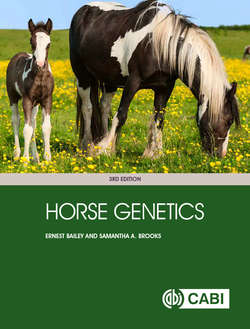Читать книгу Horse Genetics - Ernest Bailey - Страница 47
На сайте Литреса книга снята с продажи.
Genetic code
ОглавлениеDNA is an information molecule. It contains all the information necessary to transform a single cell, specifically a fertilized egg, into a complex, multicellular individual. Scientists were initially surprised that a molecule with only four basic units—A, T, G, and C—could deliver sufficient information. However, the information was found to be contained in the precise order of bases along the molecule. Each DNA molecule is millions of base pairs long with any one of the four bases possible at each position. The number of possible, random permutations of base order for chromosomes exceeds the number of animals that have ever existed! However, this is an information molecule and the order of bases is not random.
The function of a protein is based on the precise number and order of amino acids in its composition. The DNA sequence specifies the order and composition of amino acids in a protein based on a three-nucleotide code. Each group of three nucleotides that specify a particular amino acid is called a “codon.” As ribosomes move down RNA molecules, they begin at a precise point, determined by multiple factors (including the start codon, AUG), read the DNA sequence as a set of three nucleotides, then jump to the next set of three. Codons do not overlap. Each set of three is read in sequence. The triplet codes of RNA bases for amino acids are shown in Table 4.1.
Because four possible bases are used to create codons of three bases, there are 64 possible codons (43). As shown in Table 4.1, the 64 codons are used to signal the 20 amino acids (listed in columns 1 and 3) as well as to provide a signal to start (START) or stop (STOP) protein production. As there are 64 possibilities for 20 amino acids and two signals (start and stop), most amino acids can be encoded by more than one codon. This is referred to as “redundancy of the genetic code.” For example, alanine, in the top left corner of Table 4.1, is encoded by four different codons. Only two amino acids, methionine and tryptophan, have a single codon. The amino acids with the largest number of possible codons are arginine, leucine, and serine with six each.
